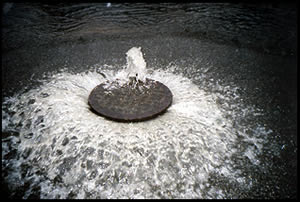Infiltration/Inflow
Infiltration/Inflow (I/I)
Infiltration/Inflow (I/I) refers to the process by which groundwater and stormwater enter a sanitary sewer system. This phenomenon can lead to significant issues in the management and treatment of wastewater, causing overflows, increased treatment costs, and environmental pollution.
Infiltration[edit | edit source]
Infiltration is the process by which groundwater enters the sanitary sewer system through cracks, joints, and other defects in the sewer pipes. This can occur due to aging infrastructure, poor construction practices, or natural ground movements. Infiltration typically happens continuously and can be exacerbated by high groundwater levels.
Sources of Infiltration[edit | edit source]
- Cracked or broken sewer pipes
- Defective pipe joints
- Deteriorated manholes
- Poorly connected service laterals
Inflow[edit | edit source]
Inflow is the process by which stormwater enters the sanitary sewer system through direct connections such as downspouts, storm drains, and other improper connections. Inflow usually occurs during and immediately after rainfall events, leading to a sudden increase in the volume of water entering the sewer system.
Sources of Inflow[edit | edit source]
- Roof downspouts connected to the sewer system
- Storm drain cross-connections
- Sump pumps discharging into the sewer system
- Manhole covers with holes or other defects
Impacts of Infiltration/Inflow[edit | edit source]
The presence of I/I in a sanitary sewer system can have several negative impacts, including:
- Increased wastewater treatment costs due to the higher volume of water that needs to be treated
- Sewer overflows, which can lead to environmental pollution and public health risks
- Reduced capacity of the sewer system to handle actual wastewater flows
- Increased wear and tear on the sewer infrastructure
Detection and Mitigation[edit | edit source]
Detecting and mitigating I/I is crucial for maintaining the efficiency and effectiveness of a sanitary sewer system. Common methods for detecting I/I include:
- Smoke testing
- Dye testing
- Closed-circuit television (CCTV) inspection
- Flow monitoring
Mitigation strategies may involve:
- Repairing or replacing damaged sewer pipes
- Sealing manholes and pipe joints
- Disconnecting improper inflow sources such as downspouts and sump pumps
- Implementing regular maintenance and inspection programs
Regulatory and Environmental Considerations[edit | edit source]
Regulatory agencies often set standards and guidelines for managing I/I to protect public health and the environment. Compliance with these regulations is essential for municipalities and utility operators to avoid penalties and ensure the sustainability of their sewer systems.
See Also[edit | edit source]
References[edit | edit source]
External Links[edit | edit source]
Search WikiMD
Ad.Tired of being Overweight? Try W8MD's physician weight loss program.
Semaglutide (Ozempic / Wegovy and Tirzepatide (Mounjaro / Zepbound) available.
Advertise on WikiMD
|
WikiMD's Wellness Encyclopedia |
| Let Food Be Thy Medicine Medicine Thy Food - Hippocrates |
Translate this page: - East Asian
中文,
日本,
한국어,
South Asian
हिन्दी,
தமிழ்,
తెలుగు,
Urdu,
ಕನ್ನಡ,
Southeast Asian
Indonesian,
Vietnamese,
Thai,
မြန်မာဘာသာ,
বাংলা
European
español,
Deutsch,
français,
Greek,
português do Brasil,
polski,
română,
русский,
Nederlands,
norsk,
svenska,
suomi,
Italian
Middle Eastern & African
عربى,
Turkish,
Persian,
Hebrew,
Afrikaans,
isiZulu,
Kiswahili,
Other
Bulgarian,
Hungarian,
Czech,
Swedish,
മലയാളം,
मराठी,
ਪੰਜਾਬੀ,
ગુજરાતી,
Portuguese,
Ukrainian
Medical Disclaimer: WikiMD is not a substitute for professional medical advice. The information on WikiMD is provided as an information resource only, may be incorrect, outdated or misleading, and is not to be used or relied on for any diagnostic or treatment purposes. Please consult your health care provider before making any healthcare decisions or for guidance about a specific medical condition. WikiMD expressly disclaims responsibility, and shall have no liability, for any damages, loss, injury, or liability whatsoever suffered as a result of your reliance on the information contained in this site. By visiting this site you agree to the foregoing terms and conditions, which may from time to time be changed or supplemented by WikiMD. If you do not agree to the foregoing terms and conditions, you should not enter or use this site. See full disclaimer.
Credits:Most images are courtesy of Wikimedia commons, and templates, categories Wikipedia, licensed under CC BY SA or similar.
Contributors: Prab R. Tumpati, MD


